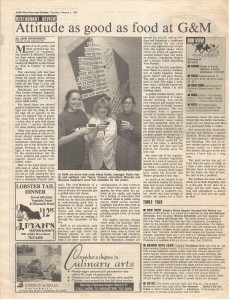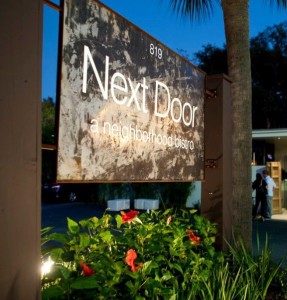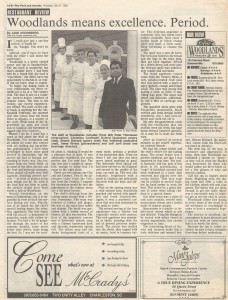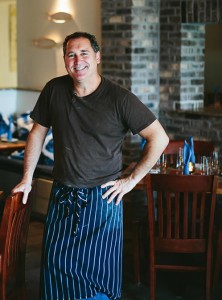FLASHBACK
We love our local restaurant community and have been keeping our fingers on the pulse for 70 years. One of our favorite past times is to read and collect the restaurant reviews found weekly inside The Post and Courier. Going back to the days of Peter Herman and Jane Kronsberg, we have hundreds of them that we love reading every so often and reliving some of our city’s past as it relates to food.
Since we love reading them so much, we thought it would be fun to share with our customers and community friends. As part of our new website redesign, we are excited to have a special section dedicated to showcasing the old reviews alongside a “where are they now” report. We will select a new review every week and post it. We will also have a fun update on the restaurant, the chef or even the menu as it is today as part of the recap. It is part of our “Flashback Fridays” and we hope you will enjoy.
Flashback Friday: Charleston Cuisine Ten Years Ago 3.27.15
 A staple every year is American Cuisine’s “Charleston Cuisine” menu book that features a variety of local chefs, along with a profile on their respected restaurant and their current menu. As a change for this week’s Flashback Friday, we look at the 2004 book cover. Ten years ago Charleston looked very different than it does today and we highlight some of those changes below:
A staple every year is American Cuisine’s “Charleston Cuisine” menu book that features a variety of local chefs, along with a profile on their respected restaurant and their current menu. As a change for this week’s Flashback Friday, we look at the 2004 book cover. Ten years ago Charleston looked very different than it does today and we highlight some of those changes below:
- John Zucker, Cru Cafe: Cru Cafe is a lowcountry institution and Chef Zucker has continued to offer great food in this charming single house. The restaurant celebrates its 15th year anniversary this year….cheers to that!
- Aaron Siegel: At the time of the photo, Aaron was executive chef at Blossom. In 2006, he left and opened Home Team BBQ in West Ashley and now has a location in Sullivan’s Island and will soon open a downtown spot.
- Craig Deihl, Cypress: Chef Deihl is still chef at Cypress and has gone on to open Artisan Meat Share future expanding his charcuterie offerings for the city.
- MariElena Dickson, Robert’s of Charleston: MariElena Raya, daughter of fame local chef Robert Dickson, has since married Joe Raya and together opened The Gin Joint where Robert’s was located. They also started Bittermilk, a company making and selling craft cocktail mixers.
- Marc Collins, Circa 1886: Ten years ago, Chef Collins was working hard on the original Planning Committee for the Charleston Wine + Food Festival and has been chef at Circa 1886 for over ten years. Circa 1886 just completed a restoration and continues to be a local favorite.
- Scott Crawford, Woodland’s: Woodland’s has since closed and Chef Crawford has moved to Raleigh where he is working on opening Standard Foods in a few months.
Who do you recognize from this photo?
We applaud those chefs who 10 years later are still a significant part of Charleston’s ever evolving culinary scene. Who will be around in another 10? We will have to wait and see.
FlashBack Fridays Review: Gaullart & Maliclet Café Restaurant 11.14.14
One of the longest running restaurants in Charleston is Gaullart & Maliclet Café Restaurant (G&M). Also known as Fast and French, the restaurant opened in the summer of 1984 in its current location at 98 Broad Street in the historic district of downtown Charleston, SC. Opened by Gwylene Gallimard and Jean-Marie Mauclet, the restaurant features a multi-generational team dedicated to providing “fresh, affordable, healthy, global cuisine with French flair in a social environment that encourages community, transparency and the Arts,” according to their website.
Gaullart & Maliclet this year celebrated 30 years in business—a milestone matched by few others. In the last 30 years, the restaurant has endured a myriad of challenges including Hurricane Hugo, the construction of the county courthouse, and nearly losing their building altogether, as discussed in this Charleston City Paper article from 2009.
The review we have is from Jane Kronsberg’s 1995 visit to G&M. Kronsberg spoke fondly of the quaint eatery noting its international cuisine and French focus. She wrote about it as a neighborhood mainstay offering a familiar and cozy place to grab a morning pick-me-up or afternoon nosh. The close quarters and old-fashion feel evoked a sense of community among its patrons, which ranged from locals working on Broad Street, tourists, and residents from the neighborhood.
She boasted about the dinner menu, the reasonable prices, top-notch service, and the Thursday night fondue—a special feature that remains a diner favorite today.
G&M has managed to maintain its foothold and cult-like following even as a recent influx of French cuisine has fallen upon the city. French restaurants in and around Charleston include: 39 Rue De Jean, Annie’s Bistro, Bistro Toulouse, Bougnat Restaurant, Brasserie Gigi, Chez Nous, Fat Hen, and Hege’s—and many of these opened just this year. With the pace of change in the restaurant industry in Charleston, it seems as though there will always be a “new kid on the block.” But sometimes what is needed most is to reconnect to industry elders like Gaullart & Maliclet.
FlashBack Fridays: The Colony House Review 10.31.14
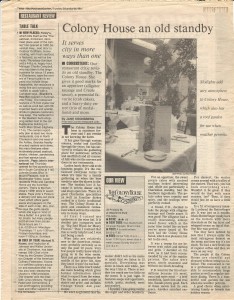 Review Date: Thursday, December 26, 1991
Review Date: Thursday, December 26, 1991
Located at 35 Prioleau Street at Waterfront Park, The Colony House was “an old standby,” with a lengthy history.
The Colony House was opened by the late Bill Snipes, who had previously opened The Sergeant and The Flag Room in the 1950s. Under his direction, the restaurant focused on beef, seafood, and traditional Southern dishes.
During the 1970s, Franz Meier, Chris Weihs, and Harry Waddington purchased The Colony House and shifted the focus to wine and international cuisine. The trio established The Wine Cellar, an addition to the main dining room that featured a French menu with a wine list that was exceptionally robust for the time.
After nearly 20 years, The Colony House was purchased by Dick Elliott of Maverick Southern Kitchens, who reopened the restaurant by hosting a fund-raising event for the Charleston Arts Council.
Jane Kronsberg visited the restaurant on more than one occasions. This review was written while under Elliott’s ownership. Kronsberg made note that the restaurant had been through a multitude of changes over the years, but it remained the dining room of choice for politicians and other important members of the community. Under new ownership, the menu once again featured traditional Lowcountry dishes, offering everything from soup and salad to seafood, beef, poultry, and pasta.
Kronsberg commented that The Colony House wine list was arranged according to suggested food pairings, which she surmised was designed to help American diners who were only recently introduced to sizable wine lists.
Three years after Kronsberg’s visit, The Colony House shuttered, bringing to a close a four-decade history of one of Charleston’s earliest fine dining establishments.
In 1994, The Harbor Club opened in its place.
Flashback Fridays: Two Decades at 819 Coleman Boulevard 10.17.14
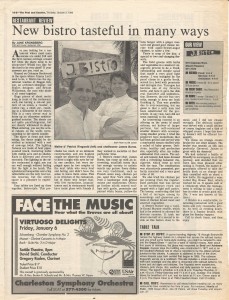 Several months have passed since the first signs of construction appeared at 819 Coleman Boulevard in Mount Pleasant. And since then, we’ve heard rumors, followed by several articles featuring renderings of the concept to come.
Several months have passed since the first signs of construction appeared at 819 Coleman Boulevard in Mount Pleasant. And since then, we’ve heard rumors, followed by several articles featuring renderings of the concept to come.
Earlier this week, Eater Charleston caught up with the man behind the new project, John Adamson of The Rarebit and Big John’s, reporting that The Americano will open by the end of this month. Described as a “1940s beach bar,” The Americano will have a Latin American and Mexican menu with Cuban flavors. The photographs reveal splashes of vibrant colors against a white backdrop, contemporary furnishings, vintage touches and plenty of greenery.
The Americano could prove to be a rather unique concept to call this location home in the past two decades. Looking back through our library of old reviews, we found one for J. Bistro, along with evidence of several restaurants that have since come and gone at this spot.
In 1995, Jane Kronsberg reviewed J. Bistro, a restaurant that was previously Jimmy Lou’s. J. Bistro was described as an affordable and tasteful spot featuring traditional menu items and newer concepts, from chicken pot pie to glazed goat cheese terrine. James Burns was the chef and owner of the restaurant. Gil Schuler, a mainstay of Charleston’s design industry and good friend of Limehouse Produce, did the logo and design work.
“The entire space is a pleasure to experience,” wrote Kronsberg, ending her piece by summarizing, “J. Bistro is a comfortable, interesting restaurant with a good menu and very reasonable prices.” The establishment did well in the neighborhood for several years, but eventually would close, starting an unfortunate trend for the location during the next decade.
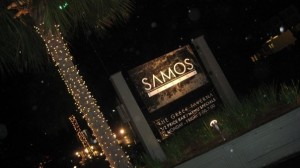 In 2009, Samos Taverna appeared on the scene. Offering a Mediterranean and Greek-style tapas menu, the restaurant’s cuisine was described as that of the Greek island of Samos, complete with Greek wines. Samos shuttered after about two years.
In 2009, Samos Taverna appeared on the scene. Offering a Mediterranean and Greek-style tapas menu, the restaurant’s cuisine was described as that of the Greek island of Samos, complete with Greek wines. Samos shuttered after about two years.
Next at 819 Colemand Boulevard came Next Door Bistro. Opening in August of 2011, Next Door was the project of executive chef and owner Ben Berryhill, who has Red Drum down the street. The Bistro was part pizza place, part Italian restaurant, and part French bistro. And just as fast as it appeared, Next Door Bistro disappeared, closing after a final night of service on October 5, 2012.
The Americano is not part Italian, not part French, nor was it a bistro or tavern. Perhaps this new concept that calls upon the nostalgia of the 40s will break the streak of turnover at this address. See the latest on The Americano here.
We hope the best to anyone who shares our love for classic convertibles!
Flashback Fridays: The Woodlands, with Chef Ken Vedrinski 10.3.14
“Woodlands means excellence. Period.” The title of Jane Kronsberg’s 1995 review of The Woodlands Resort & Inn codified the entirety of the dining experience—the food, the ambience, and the service. The Woodlands, located in Summerville, SC, was fine dining at its best. It was recognized as such by a multitude of awards that came in years following this review, including the only Mobile Five-Stars awarded in the state, and the only perfect score for food by Conde Nast Travel in 2002.
At the helm was Chef Ken Vedrinski, who, Kronsberg wrote, “is a master of his craft.” Coming from the acclaimed SwissÔtel Atlanta, Vedrinski brought principles of flawless execution kept lively with creativity and introduction of local, seasonal ingredients and an early adoption of the farm-to-table philosophy, a practice that earned him a place on The Today Show.
After a wildly successful start to his culinary career in the Lowcountry, Vedrinski left The Woodlands to build a restaurant of his own. He opened Sienna in Daniel Island, SC, and thus began his career as a restaurant owner and chef of Italian cuisine.
Recently, we checked in with Chef Vedrinski to talk about the development of his career, his Italian influences, and to get his take on the restaurant industry in Charleston.
The review of The Woodlands was written in 1995, how has the restaurant industry changed since then?
Ken Vedrinski (KV): Charleston wasn’t known as a culinary town. Back when I was at The Woodlands, there were only a few fine dining restaurants, Restaurant Million being one. Frank Lee and a few others were making marks downtown, but Charleston’s well-known chefs of today had not come to town, some weren’t even born yet.
Back then, most restaurants were still pretty basic; we questioned whether Charleston was ready to move beyond shrimp and grits and Frogmore stew. We found success with a modest number of local foodies supported by a steady stream of travelers from outside the region. The Woodlands was the first in the area to receive national accolades, and I believe it was part of what put Charleston on the map, along with the work of Marlene and Louis Osteen and the Salute to Southern Chefs. That’s when things began to change for the city.
The result of this work, and perhaps the most profound change for Charleston, Vedrinski said, has been the recent exponential increase in restaurants. He commented that the influx of new places is adding pressure to kitchen staff and front-of-house staff, as well. The lack of service and back-of-house staff has been reported on already, but Vedrinski went as far as to warn of a potential decline if businesses cannot find enough high quality, professional cooks to support their chefs, or adequately trained waitstaff to attend to their diners. “What we don’t want is to look back years from now and see a restaurant graveyard,” Vedrinski stated.
Vedrinski left The Woodlands to open Sienna, his first Italian-only venture, where he wore the chef’s hat along with the weighty responsibilities of a first-time owner.
KV: I learned how to be a restaurateur by going through it—chefs and owners are two very different things. Chefs don’t need to know anything about HR, insurance, and the like. Chef-owners need to be business savvy and understand every single vendor they work with, or they pay the price. As a chef, I never really knew where the money went, but when I opened Sienna, I quickly learned where it was being spent, and especially became aware when it wasn’t there.
Recalling hard lessons, Vedrinski shared the first time he had to pass on purchasing a special, high-priced ingredient because the money was not available, and sorrowfully recalled the moment when he could not make payroll on time. “Chefs have to learn by going through the ordeal of seeing what everything costs. Now, you’re no longer just cooking, you need to be well-rounded and understand every aspect of the business,” he said. Vedrinski lamented, “The world is full of great chefs who’ve lost great restaurants.”
After handing over the reins at Sienna, Vedrinski looked to the Charleston peninsula for a second course of Italian cuisine. In 2008, he opened Trattoria Lucca as the sole owner, chef, and sommelier. Noticing the rareness of a chef who is also a sommelier, we asked Vedrinski what his understanding of wine brings to his cooking.
KV: Italian cuisine has great synergy between food and wine – wine is a huge part of the Italian food scene, and the pairings are important. You can sit down with someone else, a hired sommelier, but it can sometimes feel like you’re speaking Chinese when talking about the ingredients and the flavors of your food. Besides, who knows the chef’s food better than the chef? Being a sommelier makes choosing and pairing the wines so much better.
I also love to drink Italian wine and took a huge interest in it. During trips to Italy, I went to the winemakers and saw what they were doing. I know the makers of about half the wines on our list and have been to their vineyards. This helps me understand the nuances of flavors, where they come from, and how they will work with my dishes. I can also help our guests choose a wine while telling them the story of the winemakers and their vineyards—and I think this adds tremendously to the experience at Lucca.
Vedrinski opened Lucca contented with the idea that it would be his focus for the foreseeable future; however, the opportunity arose for a new location well beyond the peninsula, one that he saw as a challenge in authenticity. He opened Coda del Pesce in 2013 on the Isle of Palms, a small beach community outside the city that typically catered to tourists.
Cultivated from his Italian heritage and travels to Italy, Vedrinski’s understanding of true and authentic Italian cuisine is rooted in the traditional ways of the people in the region—the cuisine is curated by the trades of the Italian people and their use of the land and its resources. He was adamant about maintaining this level of fidelity in what he served, regardless of the address.
KV: Italian food is peasant food, a humble and simple cuisine, and each town or region has its own style. They use uncomplicated ingredients from the farmers and artisans nearby, a practice that was once done here with the use of rice and other grains in traditional Gullah cuisine. I see the return of this in Charleston—farming, craftsmanship, and artisanal products coming back—as a very good thing for the culinary industry. But we’re not there yet. Italian in America is mostly “Americanized,” with overly ground meats, cheap ingredients, and the use of too much cheese. Even on the beach, I was not going to do this. I’d go broke before cooking like that.
As the sole proprietor of Coda del Pesce, Vedrinski is unencumbered by the influence of an owner or investor and is not driven by the bottom line—a freedom that allowed him to take a chance putting an Italian restaurant in a southern beach town. He is determined to share with Charleston and its many visitors the pleasantness of genuine Italian fare, whether through the use of Italian ingredients, Italian wine, or by showcasing the Italian application of being content preparing simple ingredients found around you. “There is a little luck involved, but if it tastes good and there’s value in it, people will come.”
During our talk, Chef Vedrinski humbly abridged more than two decades of restaurant experience through his eyes as a chef, owner, and sommelier. We hope to continue learning and sharing teachings from Ken and other industry veterans as the culinary environment grows and evolves.
